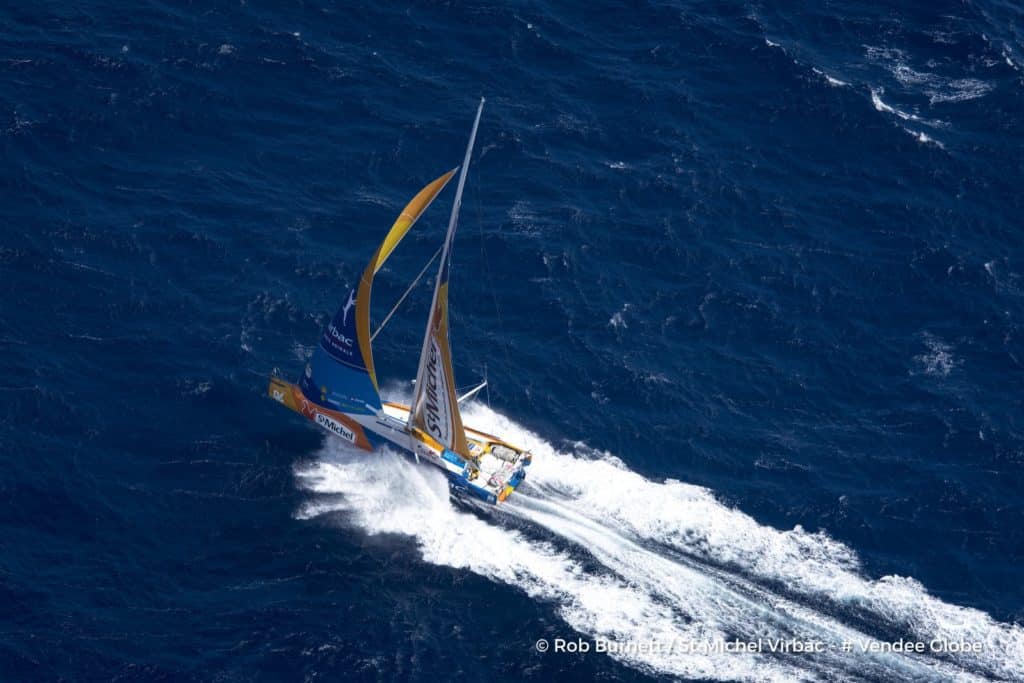
The big blow had been forecast for several days and required drastic measures. The winner was Jean Le Cam, who thanks to his position further back and further south, was able to continue to make headway under reduced sail without ever getting stopped or changing his heading. This is something that Yann Eliès was unable to do and in the end it was the skipper from St. Brieuc, who bore the brunt of the angry weather in the south. This is the second time in the eighth Vendée Globe that skippers have had to modify their trajectory to avoid getting battered by a deep low. The first time was when a tropical low crossed the middle of the Indian Ocean. Yann Eliès suffered the most, being forced to slow down on that occasion while Paul Meilhat and Jérémie Beyou put their foot down to get away from the worst conditions, although the skipper of Maître CoQ did see his hook ripped off and mainsail torn.
This time the skipper of Quéguiner-Leucémie Espoir was accompanied by two other sailors: Jean-Pierre Dick headed 800 miles NE to pass through the Bass Strait and even between the Furneaux islands and Tasmania. This is the first time that a Vendée Globe skipper has raced through these straits, which are well known for being nasty and angry at times, but it was an opportunity to avoid the heaviest weather. However, the cost in terms of the race has been high, as while the skipper from Nice has maintained his advantage over Eliès, he is now 450 miles further north and has given up sixth place to Jean Le Cam (Finistère Mer Vent), who has gained almost 400 miles in 48 hours. The skipper of StMichel-Virbac will benefit from a decent angle to head back down towards Stewart Island to the south of New Zealand in a moderate breeze and calmer seas than his two closest rivals, but it looks like he has lost 300 miles in this northerly option. However, he has ensured that his boat is safe and avoided damage to his equipment. The contest looks like being interesting in the coming days between these three, as they enter a lively Pacific today.
The Campbells are coming
What is unusual about this storm is that it deepened as it approached the Pacific. In the worst of the storm, there are winds in excess of 55 knots this morning, as it slips south-eastwards to pass to the south of New Zealand. The three skippers, who have spread right out in the Tasman Sea can see that this storm will be affecting the pair ahead of them, Paul Meilhat (SMA) and Jérémie Beyou, who passed Auckland Island this morning and then Campbell Island. Since the Indian Ocean, when Maître CoQ got left behind losing 250 miles, Jérémie Beyou has got back up to speed and is now only sixty miles or so behind.
The pair will be pushed along by this area of low pressure, which is still not filling, as it continues to head down to the pack ice. This should allow them to accelerate and close the gap slightly on the two frontrunners. At the front, the pace has changed. They are still fast for the moment, but that is set to change over the next few hours. The shallow low will even be offering headwinds to Armel Le Cléac’h (Banque Populaire VIII), as he makes his way along the edge of the exclusion zone at 52°S. This shallow low will be moving slowly eastwards. Positioned some 200 miles further north, Alex Thomson (Hugo Boss) hopes to make the most of a small low, but before that he is going to have to cross the area of light SE’ly winds and a transition to very light northerlies with areas of calm. At this point, it is hard to say who will come off best and get first to the huge high, which has settled ahead of Cape Horn. This could be the big turning point in the race, as another low is expected to develop this weekend on the edge of the high. But in general, the next few days look quiet for the two out in front. It is hard to plan a route to Drake Passage with a lot of uncertainty ahead.
As for the pack in the Indian Ocean, they are dealing with a series of low-pressure systems, which come after each other every couple of days. Louis Burton (Bureau Vallée) is alone out in front approaching the longitude of Cape Leeuwin that he should cross late today, while the rest of the fleet are between 45°S and 47°S with more or less wind. It is those at the back that tend to be getting the roughest conditions with a front moving towards the Kerguelens. That is why Eric Bellion (Commeunseulhomme) and especially Pieter Heerema (No Way Back) have moved back up to 40°S for the former and 37°S for the latter. They still have 4000 miles to sail to get out of the Indian Ocean.









